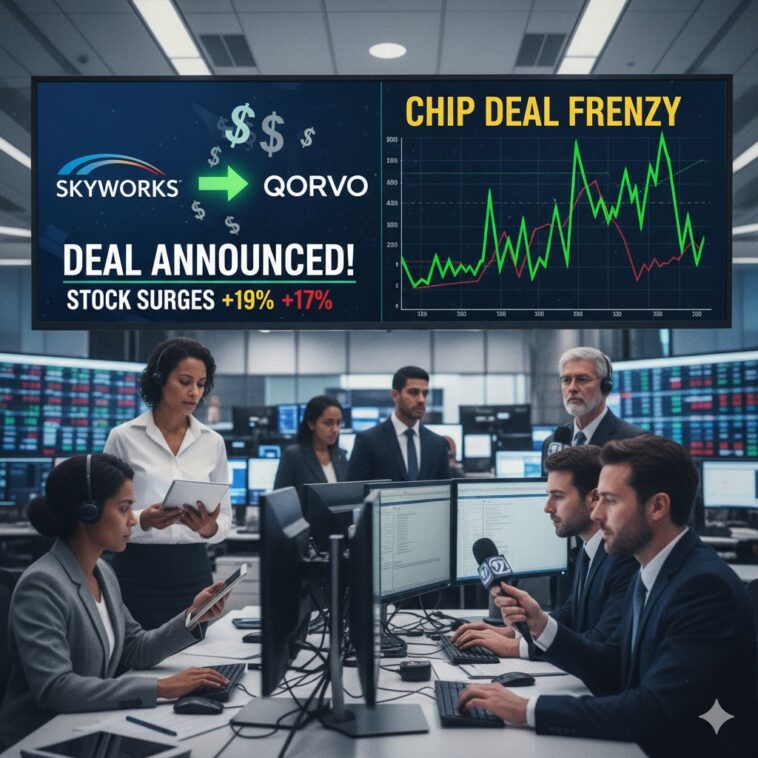Chip Deal Frenzy Ignites Market Volatility
In a move that’s sending ripples across the technology sector, Semiconductor stock took center stage late this week as Skyworks Solutions agreed to a mammoth deal to acquire rival chipmaker Qorvo. This isn’t merely another piece of M&A news; it’s a high-stakes, all-stock-and-cash gambit that immediately juiced the valuations of both firms and set a new, combative tone for the analog chip space.
Skyworks, a specialist in high-performance analog and mixed-signal semiconductors, saw its shares rocket up 19% on the news, while Qorvo, the target, surged 17%. The combined entity is slated to be valued at an impressive $22 billion—a hefty price tag in a consolidation-hungry industry. Under the terms, Qorvo shareholders are set to receive $32.50 in cash plus 0.960 of a Skyworks common share for each of their holdings. It’s a classic roll-up play, giving Skyworks shareholders approximately 63% control of the new behemoth.
The Allure of Scale in a Shifting Chip Landscape
Why the excitement? Think of it like two adjacent farms merging to gain massive economies of scale in a tough harvest season. The semiconductor stock market has been pushing for consolidation, a clear sign that chipmakers need to be bigger to compete globally and fund the relentless R&D required for 5G and IoT integration.
“This deal isn’t just about eliminating a competitor; it’s about creating a single, more robust supply chain and a deeper war chest for innovation,” said Dr. Alistair Chen, a Senior Technology Analyst at Veritas Capital Markets. “They’ve created a multi-billion-dollar entity that can now walk into negotiations with a much louder voice. Expect more of this ‘go big or go home’ attitude in the analog chip sector.”
Earnings Season: Big Beats and Unexpected Headwinds
Meanwhile, a host of other corporate giants delivered a mixed bag of earnings, proving once again that in this market, the small details often matter more than the big numbers.
The payment processing space got a jolt from PayPal Holdings, whose shares jumped 12%. Its third-quarter earnings of $1.34 per share comfortably topped the consensus estimate of $1.20. Crucially, the company initiated a quarterly dividend of 14 cents per share. Investors loved that. A dividend, even a small one, signals a shift from pure growth to mature, shareholder-return-focused operations.
On the logistics front, UPS surged 10%, posting a third-quarter revenue of $21.4 billion that far exceeded the Street’s forecast of $20.83 billion. The company also surprised with adjusted earnings of $1.74 per share, easily beating the $1.24 consensus. This was a clear example of operational efficiency shining through, but the forward-looking fourth-quarter guidance also topped expectations, which is what really moves the needle.
Over in e-commerce, Wayfair, the online home goods retailer, put up better-than-anticipated Q3 earnings, earning an adjusted 70 cents per share against an LSEG-polled forecast of 43 cents. Revenue also nudged past expectations.
When a Beat is Still a Miss
But not everyone was celebrating a beat. Corning, the fiber optic cable maker, is a case study in why earnings reports are often parsed to the thousandth degree. The stock fell 6% despite adjusted results and guidance that technically topped Wall Street estimates. The issue? Margin and cash flow. A core operating margin of 19.6% was just shy of the Street’s 20.1% estimate. Worse, cash from operations was a dismal $784 million, a far cry from the $1.07 billion analysts had expected. Free cash flow told a similar, disappointing story.
“Corning’s report is a perfect demonstration that the quality of earnings matters as much as the headline figures,” observed Jane Liu, a portfolio manager at Atlas Financial Group. “Missing on cash flow by that much—that’s a serious red flag on working capital management. The market is increasingly unforgiving of a cash-flow miss, even if revenue is fine.”
The volatility wasn’t limited to one sector. Rambus, another semiconductor stock player, tumbled 15%. This came despite a revenue beat, as earnings of 44 cents per share trailed the prior year’s result of 45 cents. After shares had already doubled in the past six months, even a slight stumble was enough to trigger a sharp correction, a classic “sell the news” reaction.
Meanwhile, a security incident disclosure led F5, the multi-cloud security provider, to drop 9%, even as its top line came in better than anticipated. In homebuilding, D.R. Horton fell 5% after its per-share earnings missed analysts’ expectations by roughly 7%.
The Last Word: Navigating the Cash-Flow Crux
The market is clearly in a mood of discerning selectivity. Strong guidance and strategic pivots are rewarded (PayPal’s dividend, UPS’s efficiency), while even slight margin or cash-flow disappointments are severely punished (Corning, Waste Management). It’s a sign of a high-interest-rate environment where the cost of capital is elevated: cash is king, and profits must be quality profits.
“The biggest takeaway from this earnings cycle is a heightened sense of risk aversion,” Dr. Chen concludes. “The Skyworks/Qorvo deal gives the sector a burst of adrenaline, but for the average company, the focus is now relentlessly on free cash flow generation. Investors are demanding proof of sustainability, not just a flashy revenue number.”



